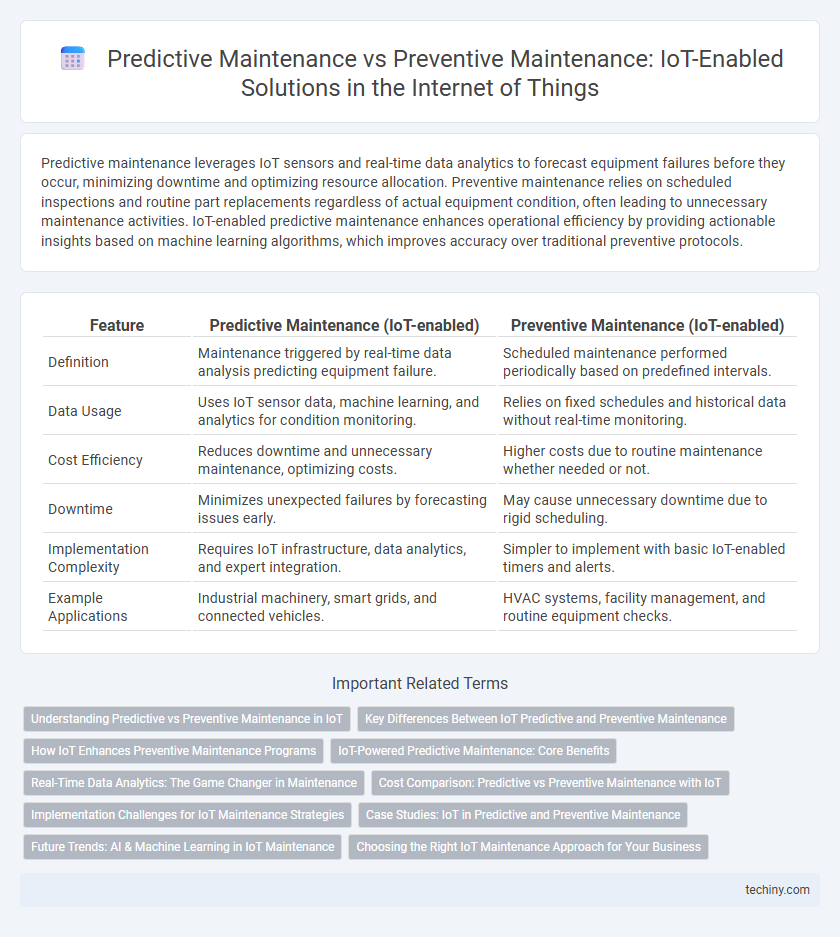Predictive maintenance leverages IoT sensors and real-time data analytics to forecast equipment failures before they occur, minimizing downtime and optimizing resource allocation. Preventive maintenance relies on scheduled inspections and routine part replacements regardless of actual equipment condition, often leading to unnecessary maintenance activities. IoT-enabled predictive maintenance enhances operational efficiency by providing actionable insights based on machine learning algorithms, which improves accuracy over traditional preventive protocols.
Table of Comparison
| Feature | Predictive Maintenance (IoT-enabled) | Preventive Maintenance (IoT-enabled) |
|---|---|---|
| Definition | Maintenance triggered by real-time data analysis predicting equipment failure. | Scheduled maintenance performed periodically based on predefined intervals. |
| Data Usage | Uses IoT sensor data, machine learning, and analytics for condition monitoring. | Relies on fixed schedules and historical data without real-time monitoring. |
| Cost Efficiency | Reduces downtime and unnecessary maintenance, optimizing costs. | Higher costs due to routine maintenance whether needed or not. |
| Downtime | Minimizes unexpected failures by forecasting issues early. | May cause unnecessary downtime due to rigid scheduling. |
| Implementation Complexity | Requires IoT infrastructure, data analytics, and expert integration. | Simpler to implement with basic IoT-enabled timers and alerts. |
| Example Applications | Industrial machinery, smart grids, and connected vehicles. | HVAC systems, facility management, and routine equipment checks. |
Understanding Predictive vs Preventive Maintenance in IoT
Predictive maintenance in IoT leverages real-time sensor data and advanced analytics to forecast equipment failures before they occur, minimizing downtime and optimizing resource allocation. Preventive maintenance relies on scheduled inspections and routine servicing based on historical usage patterns, which may lead to unnecessary interventions or missed failures. Integrating IoT enhances predictive maintenance accuracy through continuous monitoring, while preventive maintenance benefits from data-driven scheduling to improve operational efficiency.
Key Differences Between IoT Predictive and Preventive Maintenance
IoT predictive maintenance leverages real-time sensor data and advanced analytics to forecast equipment failures before they occur, enabling targeted repairs and minimizing downtime. Preventive maintenance relies on scheduled inspections and routine servicing based on manufacturer recommendations or usage cycles, regardless of the actual condition of the equipment. Key differences include predictive maintenance's reliance on data-driven insights for maintenance timing, whereas preventive maintenance follows fixed intervals without condition-based adjustments.
How IoT Enhances Preventive Maintenance Programs
IoT enhances preventive maintenance programs by continuously monitoring equipment with sensors that collect real-time data on performance and wear. This data enables automatic alerts for scheduled maintenance before failures occur, reducing unplanned downtime and extending asset life. Integrating IoT platforms with maintenance management systems allows predictive analytics to optimize maintenance schedules based on actual usage patterns and environmental conditions.
IoT-Powered Predictive Maintenance: Core Benefits
IoT-powered predictive maintenance leverages real-time sensor data and advanced analytics to forecast equipment failures before they occur, reducing unexpected downtime by up to 50%. This approach optimizes maintenance schedules based on actual asset conditions, significantly lowering operational costs compared to traditional preventive maintenance. Enhanced asset lifespan and improved safety standards are direct results of utilizing IoT-enabled predictive maintenance in industrial environments.
Real-Time Data Analytics: The Game Changer in Maintenance
Real-time data analytics in IoT-enabled maintenance transforms predictive maintenance by continuously monitoring equipment health and forecasting failures with high accuracy. Unlike preventive maintenance, which relies on fixed schedules, predictive maintenance uses dynamic data streams from sensors to optimize maintenance timing, minimizing downtime and reducing costs. This data-driven approach enhances asset lifespan and operational efficiency by enabling proactive interventions precisely when needed.
Cost Comparison: Predictive vs Preventive Maintenance with IoT
Predictive maintenance leverages IoT sensors and real-time data analytics to forecast equipment failures, significantly reducing unplanned downtime and lowering overall maintenance costs by enabling targeted interventions. Preventive maintenance relies on scheduled checks regardless of asset condition, often leading to unnecessary part replacements and higher labor expenses. IoT-enabled predictive maintenance typically offers a 25-30% cost savings compared to traditional preventive approaches by optimizing resource allocation and minimizing operational disruptions.
Implementation Challenges for IoT Maintenance Strategies
Implementing IoT-enabled predictive maintenance faces challenges such as data integration from heterogeneous sensors, ensuring real-time analytics accuracy, and managing cybersecurity risks in connected devices. Preventive maintenance strategies struggle with optimizing maintenance schedules without over-maintenance, requiring precise IoT data interpretation to avoid unnecessary downtime and costs. Both approaches demand scalable infrastructure and skilled personnel to harness IoT insights effectively for asset health management.
Case Studies: IoT in Predictive and Preventive Maintenance
IoT-enabled predictive maintenance leverages real-time sensor data and machine learning algorithms to foresee equipment failures, reducing downtime and maintenance costs, as demonstrated in GE's aviation case study where engine sensors predicted faults before they occurred. Preventive maintenance, guided by IoT insights, schedules regular equipment checks based on historical data, illustrated by Siemens' smart factory project that minimizes unexpected breakdowns through timely interventions. Both approaches optimize asset performance, but IoT-driven predictive maintenance offers superior accuracy and cost efficiency by addressing issues exactly when needed.
Future Trends: AI & Machine Learning in IoT Maintenance
AI and machine learning are revolutionizing IoT-enabled maintenance by enabling predictive maintenance systems that analyze real-time sensor data to forecast equipment failures with high accuracy. These technologies reduce downtime and maintenance costs by optimizing maintenance schedules based on actual asset condition rather than fixed intervals. Future trends point to increasingly autonomous maintenance operations where AI-driven analytics continuously improve predictive models, enhancing operational efficiency and asset longevity.
Choosing the Right IoT Maintenance Approach for Your Business
Choosing the right IoT maintenance approach involves evaluating predictive maintenance, which uses real-time sensor data and machine learning algorithms to forecast equipment failures and schedule repairs only when necessary, minimizing downtime and costs. Preventive maintenance relies on scheduled inspections and routine servicing based on manufacturer guidelines or historical usage patterns but may result in unnecessary maintenance activities. Businesses benefit from leveraging IoT-enabled predictive maintenance for data-driven decision-making and resource optimization while considering preventive maintenance when system reliability and fail-safe operations are critical.
Predictive maintenance vs Preventive maintenance (IoT-enabled) Infographic

 techiny.com
techiny.com